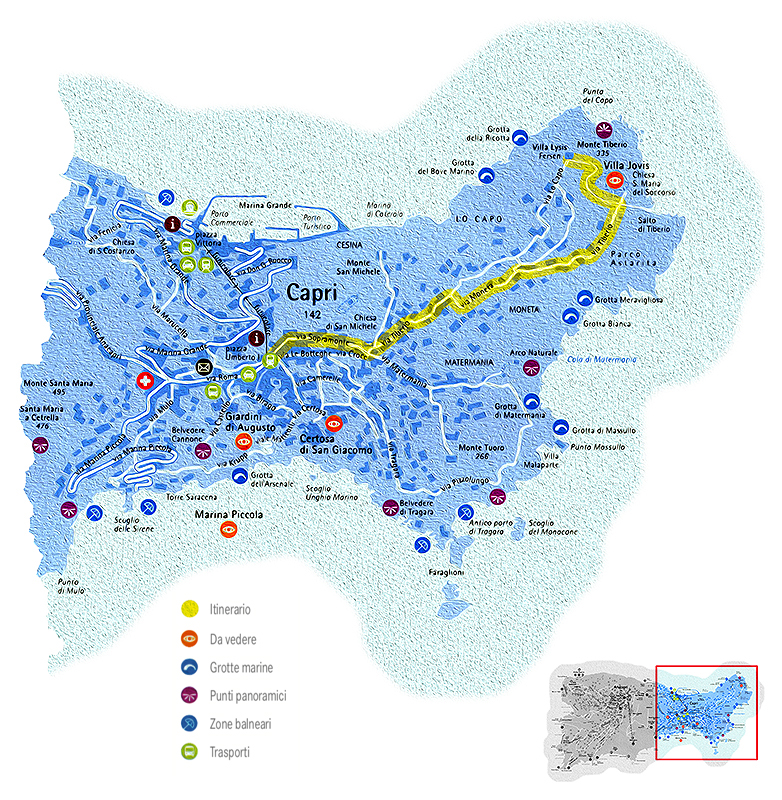
Verso Tiberio
foto di • photos by Costantino Esposito
Il nostro itinerario parte da qui, dalla piazza cuore e palcoscenico di Capri. Oltrepassato l’arco che si apre al centro della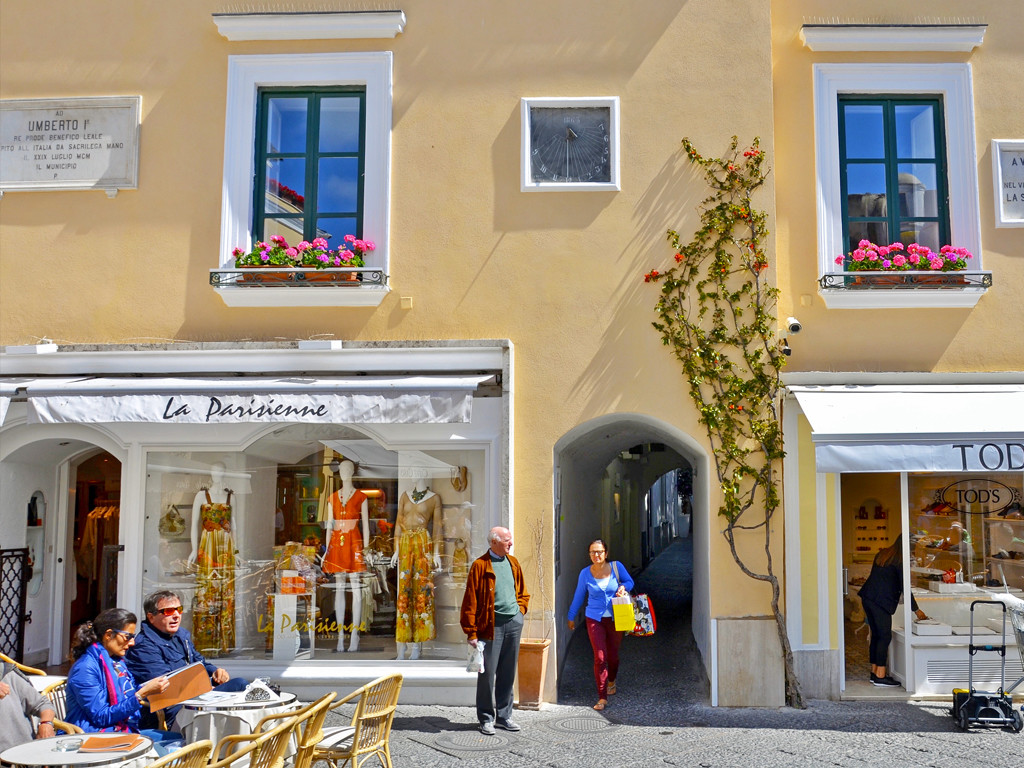 facciata del Municipio, si imbocca via Longano dove si trovano alcune delle case più antiche dell’isola e dei passaggi a volta che evidenziano il carattere medievale di questa zona.
facciata del Municipio, si imbocca via Longano dove si trovano alcune delle case più antiche dell’isola e dei passaggi a volta che evidenziano il carattere medievale di questa zona.
In fondo alla via c’è il piccolo slargo di piazza Cesare Battisti e, a destra, inizia via Sopramonte, una dolce salita lungo la quale si allargano ampie finestre di paesaggio che regalano vedute sull’altura del Castiglione, sul profilo del Monte Tuoro e uno scorcio insolito della Certosa di San Giacomo. | Towards Tiberio Our itinerary starts from here, from the piazza that is the heart and centre stage of Capri. Passing through the arch in the centre of the Town hall facade, you enter Via Longano, where you’ll see some of the oldest houses on the island, as well as vaulted passageways revealing the medieval character of the area. At the end of the street, there is a slight broadening out into Piazza Cesare Battisti, from which Via Sopramonte leads off on the right, climbing gently and offering broad vistas over the countryside, with views of the hill of Castiglione, the outline of Monte Tuoro and an unusual view of the Certosa di San Giacomo.
Chiesa di San Michele
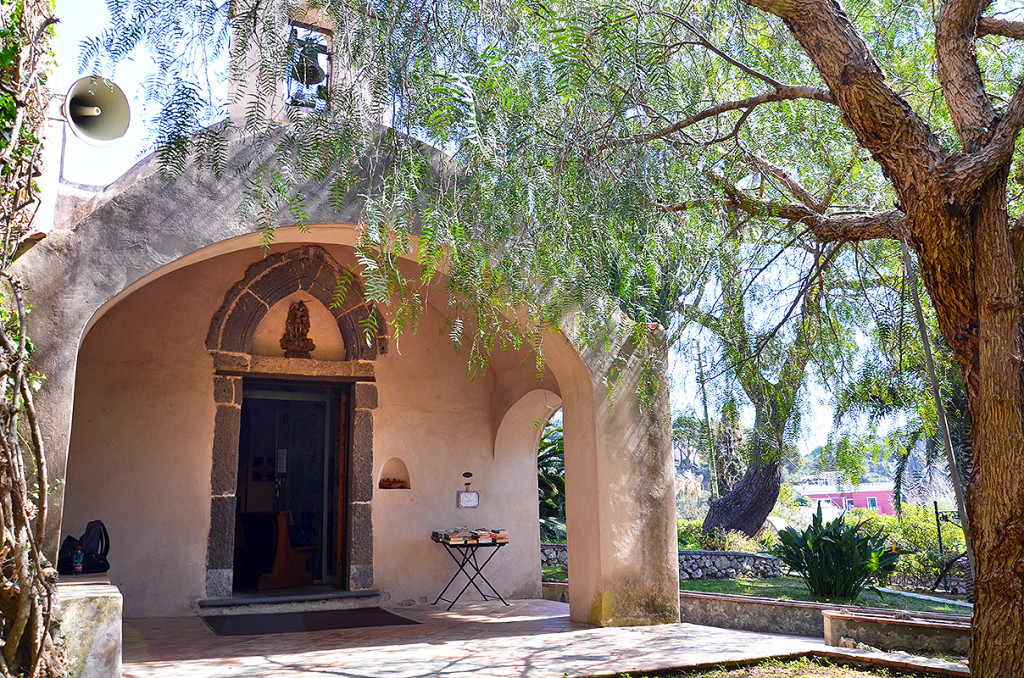 Arrivati al quadrivio della Croce, prendendo a sinistra per via Tiberio c’è l’ingresso della piccola chiesa di San Michele alla Croce, così chiamata per la grande croce posta sulla collina che la sovrasta. È circondata da un alto muro di cinta e da un giardino di flora mediterranea. Risale agli inizi del XII secolo e gli elementi architettonici che la caratterizzano testimoniano un lungo succedersi di epoche di costruzione nel tempo. | When you arrive at the Croce crossroads, turn left into Via Tiberio and you’ll find the entrance
Arrivati al quadrivio della Croce, prendendo a sinistra per via Tiberio c’è l’ingresso della piccola chiesa di San Michele alla Croce, così chiamata per la grande croce posta sulla collina che la sovrasta. È circondata da un alto muro di cinta e da un giardino di flora mediterranea. Risale agli inizi del XII secolo e gli elementi architettonici che la caratterizzano testimoniano un lungo succedersi di epoche di costruzione nel tempo. | When you arrive at the Croce crossroads, turn left into Via Tiberio and you’ll find the entrance
to the small church of San Michele alla Croce, named after the large cross that stands on the hill above it. The church is surrounded by a high wall and a garden of Mediterranean flowers.
It dates back to the early 12th century and its architectural features testify to a long series of building works from different epochs over time.
Villa Moneta
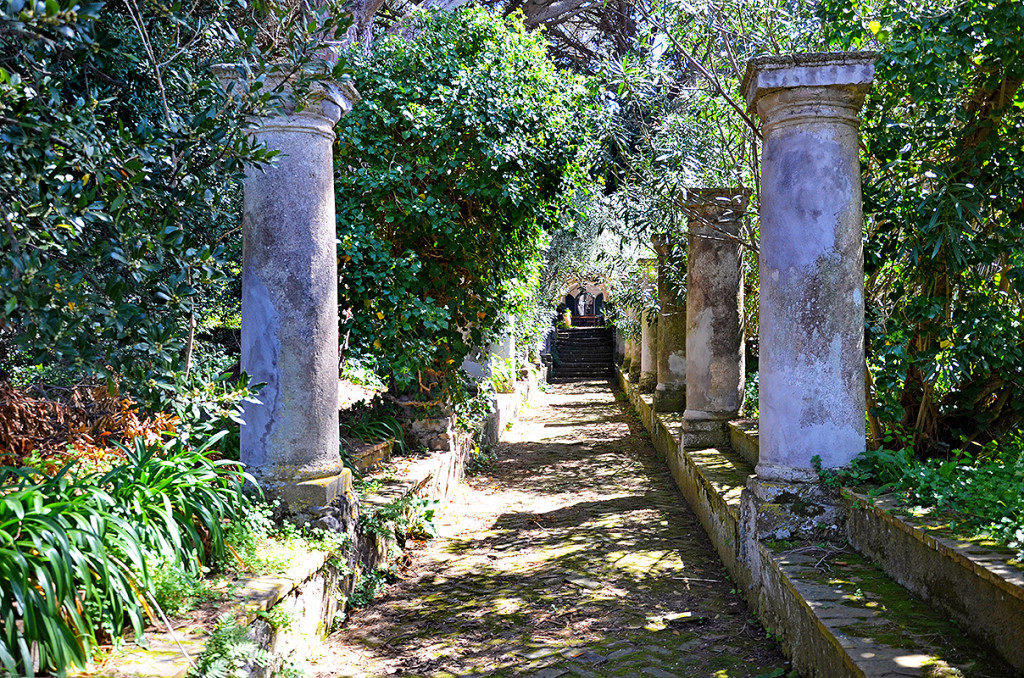 Lungo via Tiberio, al numero 32, vale una sosta il bellissimo colonnato ottocentesco che si vede attraverso il cancello di Villa Moneta, una delle più antiche ville capresi avvolta nell’ombra di una pineta antica due secoli. | At number 32 Via Tiberio, it’s worth stopping to look at the beautiful 19th century colonnade that you can see through the gates of Villa Moneta, one of the oldest villas on Capri, shrouded in the shade of two-hundred-year-old pine woods.
Lungo via Tiberio, al numero 32, vale una sosta il bellissimo colonnato ottocentesco che si vede attraverso il cancello di Villa Moneta, una delle più antiche ville capresi avvolta nell’ombra di una pineta antica due secoli. | At number 32 Via Tiberio, it’s worth stopping to look at the beautiful 19th century colonnade that you can see through the gates of Villa Moneta, one of the oldest villas on Capri, shrouded in the shade of two-hundred-year-old pine woods.
Parco Astarita
Accompagnati da un rincorrersi di orti, vigne e giardini si arriva a viale Amedeo Maiuri dove si apre il cancello di questo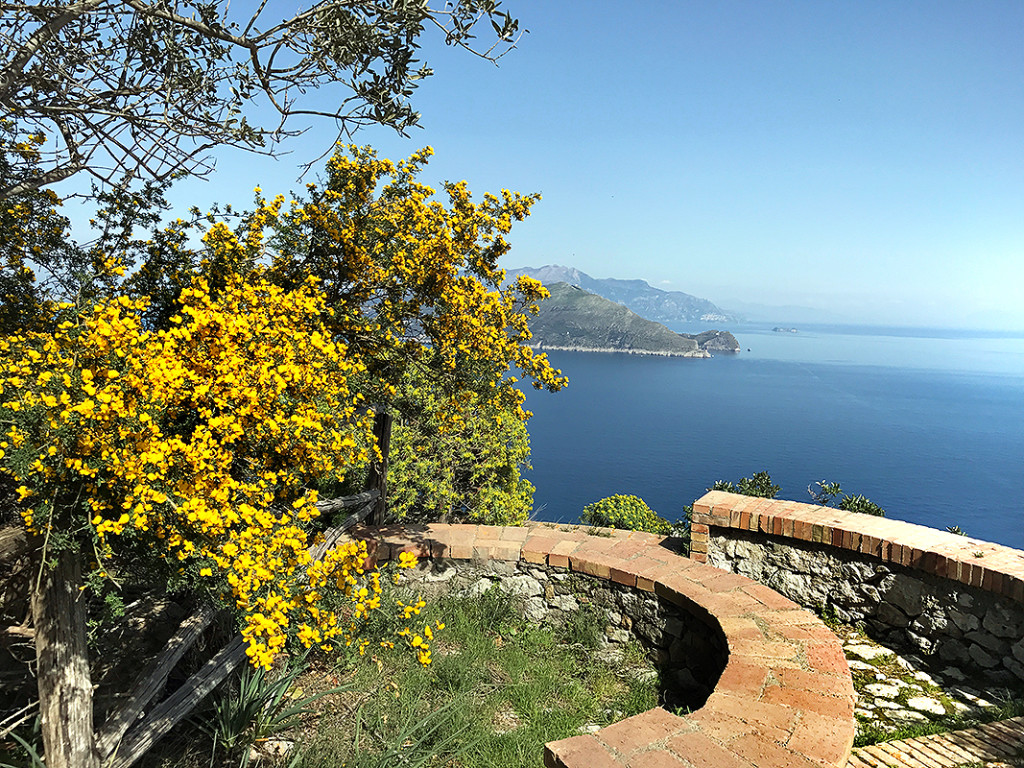 magnifico polmone verde. Un’area di 10.000 metri quadrati che nel 1978 fu donata dal banchiere Mario Astarita allo Stato e per esso alla Sovrintendenza archeologica di Napoli. Il parco regala terrazze affacciate sull’azzurro, balze e dirupi, scale che si tuffano nel blu, rotonde-belvederi aggrappate alla falesia e ornate da improbabili cipressi ma, soprattutto, panorami indimenticabili. | Accompanied by a succession of vegetable plots, vineyards and gardens, you arrive at Viale Amedeo Maiuri, where you’ll find the gate to this magnificent green lung. It’s an area of 10,000 square metres and in 1978 it was donated by banker Mario Astarita to the State, in the form of the Department of Archaeological Heritage in Naples. The park abounds in terraces overlooking the sea, rocky ledges and precipices, stairways that plunge down to the sea, rotunda-belvederes clinging to the cliff and ornamented with improbable cypresses, and, above all, unforgettable panoramas.
magnifico polmone verde. Un’area di 10.000 metri quadrati che nel 1978 fu donata dal banchiere Mario Astarita allo Stato e per esso alla Sovrintendenza archeologica di Napoli. Il parco regala terrazze affacciate sull’azzurro, balze e dirupi, scale che si tuffano nel blu, rotonde-belvederi aggrappate alla falesia e ornate da improbabili cipressi ma, soprattutto, panorami indimenticabili. | Accompanied by a succession of vegetable plots, vineyards and gardens, you arrive at Viale Amedeo Maiuri, where you’ll find the gate to this magnificent green lung. It’s an area of 10,000 square metres and in 1978 it was donated by banker Mario Astarita to the State, in the form of the Department of Archaeological Heritage in Naples. The park abounds in terraces overlooking the sea, rocky ledges and precipices, stairways that plunge down to the sea, rotunda-belvederes clinging to the cliff and ornamented with improbable cypresses, and, above all, unforgettable panoramas.
Orario di visita: 10.00-14.00. Chiuso il martedì. L’ingresso è gratuito • Visiting times: 10.00-14.00. Closed on Tuesdays. Entrance is free
Villa Jovis
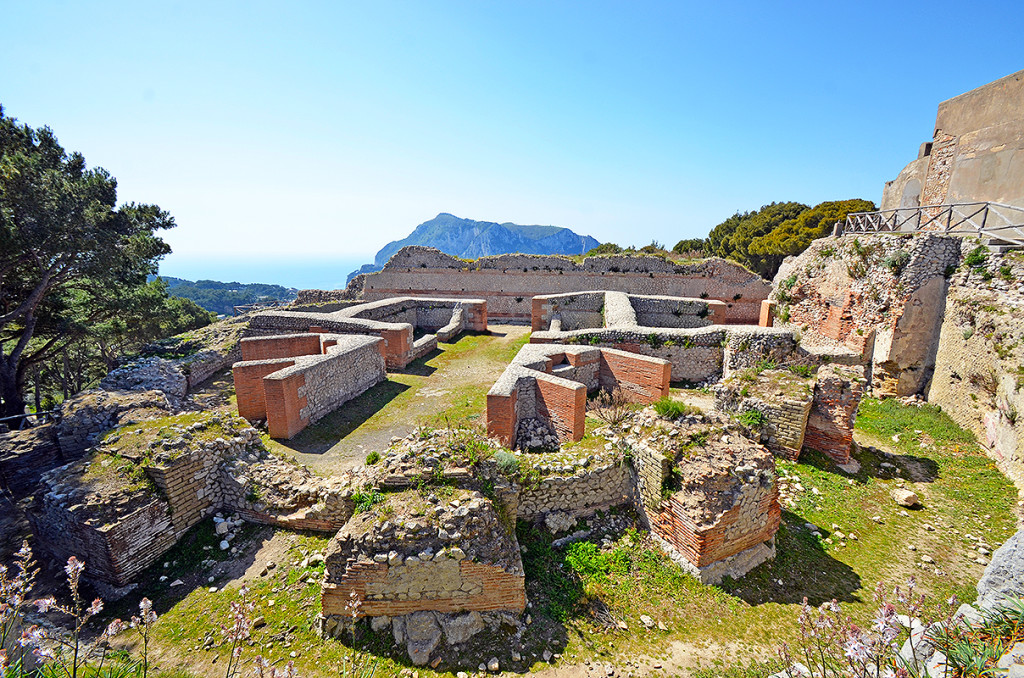 L’imperatore Tiberio trascorse a Capri gli ultimi dieci anni della sua vita. Si racconta delle sue 12 ville sull’isola ma questa è l’unica villa imperiale che si può sicuramente attribuire a lui. Si estende su un’area di circa 7.000 metri quadrati che domina l’intero promontorio di Monte Tiberio e le sue caratteristiche ricordano quelle di una piccola fortezza. | The emperor Tiberius spent the last ten years of his life on Capri. There were said to be 12 of his villas on the island but this is the only imperial villa that can definitely be attributed to him. It covers an area of about 7,000 square metres that dominates the entire promontory of Monte Tiberio and its features are reminiscent of a small fortress.
L’imperatore Tiberio trascorse a Capri gli ultimi dieci anni della sua vita. Si racconta delle sue 12 ville sull’isola ma questa è l’unica villa imperiale che si può sicuramente attribuire a lui. Si estende su un’area di circa 7.000 metri quadrati che domina l’intero promontorio di Monte Tiberio e le sue caratteristiche ricordano quelle di una piccola fortezza. | The emperor Tiberius spent the last ten years of his life on Capri. There were said to be 12 of his villas on the island but this is the only imperial villa that can definitely be attributed to him. It covers an area of about 7,000 square metres that dominates the entire promontory of Monte Tiberio and its features are reminiscent of a small fortress.
Orario di visita: marzo (dal 15), aprile: 10:00-17:00, maggio: 10:00-18:00 – giugno, luglio e agosto: 10:00-19:00 • Visiting times: March (from 15), April: 10:00-17:00, May: 10:00-18:00 – June, July and August: 10:00-19:00
settembre e ottobre: 10:00-17:00 – novembre e dicembre: 10:00-16:00 • September and October: 10:00-17:00 – November and December: 10:00-16:00
Giornata di chiusura: lunedì • Closed on Mondays
Ingresso: 2,00 euro, gratuito per i cittadini degli stati membri UE al di sotto dei 18 anni. La prima domenica di ogni mese l’ingresso è gratuito • Entrance fee: 2.00 euros, free for citizens of EU countries under the age of 18. Entrance is free on the first Sunday of each month
Il sentiero delle calanche
Si presume che questo sentiero costituisse l’originario accesso a Villa Jovis. Oggi è una passeggiata di poco più di un 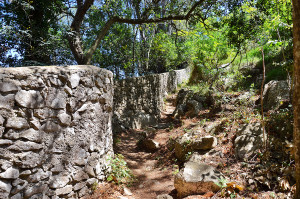 chilometro lungo il crinale di Monte Tiberio che regala panorami mozzafiato su tutto il golfo di Napoli tra macchia mediterranea e scorci d’azzurro. Gli incontri con le piccole caprette tibetane che vivono in zona Tiberio e qui pascolano liberamente sono piuttosto frequenti. Il sentiero ha qualche dislivello e qualche punto un po’ impervio, per percorrerlo sono quindi necessarie delle scarpe comode. | This path is believed to have been the original route to Villa Jovis. Now it is a walk of a little more than a kilometre along the ridge of
chilometro lungo il crinale di Monte Tiberio che regala panorami mozzafiato su tutto il golfo di Napoli tra macchia mediterranea e scorci d’azzurro. Gli incontri con le piccole caprette tibetane che vivono in zona Tiberio e qui pascolano liberamente sono piuttosto frequenti. Il sentiero ha qualche dislivello e qualche punto un po’ impervio, per percorrerlo sono quindi necessarie delle scarpe comode. | This path is believed to have been the original route to Villa Jovis. Now it is a walk of a little more than a kilometre along the ridge of 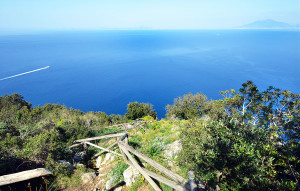 Monte Tiberio, offering breathtaking panoramas over the whole of the gulf of Naples, with Mediterranean scrub and sudden vistas of deep blue sea. You may well come across one of the small Tibetan goats that live in the Tiberio area and graze freely here.
Monte Tiberio, offering breathtaking panoramas over the whole of the gulf of Naples, with Mediterranean scrub and sudden vistas of deep blue sea. You may well come across one of the small Tibetan goats that live in the Tiberio area and graze freely here.
The path includes some climbs and is rough in places, so you’ll need comfortable shoes for the walk.
Villa Lysis
Lo scrittore Norman Douglas mostrò questo luogo a picco sul mare al conte Jacques d’Adelsward Fersen che cercava a Capri un posto dove rifugiarsi e rifarsi una vita dopo uno scandalo che lo aveva travolto a Parigi. Costruita su disegno dello scenografo e incisore Édouard Chimot fu completata nel 1905 rispecchiando l’eclettica ed eccentrica personalità del conte. È un luogo incantato e pieno di fascino anche grazie allo spettacolare panorama che offre. D’estate è spesso palcoscenico di eventi teatrali e concerti. The writer Norman Douglas showed this spot, perched high above the sea, to Count Jacques d’Adelsward Fersen who was looking for a refuge on Capri where he could rebuild his life after the scandal he had been embroiled in in Paris. Built to designs by stage designer and engraver Édouard Chimot, the villa was completed in 1905 and reflected the Count’s eclectic and eccentric personality. It is an enchanted, fascinating place, partly because of the spectacular panorama it offers. In summer it is often used to stage theatrical events and concerts.
Capri un posto dove rifugiarsi e rifarsi una vita dopo uno scandalo che lo aveva travolto a Parigi. Costruita su disegno dello scenografo e incisore Édouard Chimot fu completata nel 1905 rispecchiando l’eclettica ed eccentrica personalità del conte. È un luogo incantato e pieno di fascino anche grazie allo spettacolare panorama che offre. D’estate è spesso palcoscenico di eventi teatrali e concerti. The writer Norman Douglas showed this spot, perched high above the sea, to Count Jacques d’Adelsward Fersen who was looking for a refuge on Capri where he could rebuild his life after the scandal he had been embroiled in in Paris. Built to designs by stage designer and engraver Édouard Chimot, the villa was completed in 1905 and reflected the Count’s eclectic and eccentric personality. It is an enchanted, fascinating place, partly because of the spectacular panorama it offers. In summer it is often used to stage theatrical events and concerts.
Orario di visita: maggio, settembre e ottobre 10:00-18.00 – giugno, luglio e agosto, 10:00-19:00 – novembre e dicembre: 10:00-16:00 • Visiting times: May, September and October 10:00-18:00 – June, July and August, 10:00-19:00 – November and December: 10:00-16:00
Chiuso il mercoledì. Ingresso: 2,00 euro • Closed on Wednesdays. Entrance: 2.00 euros





